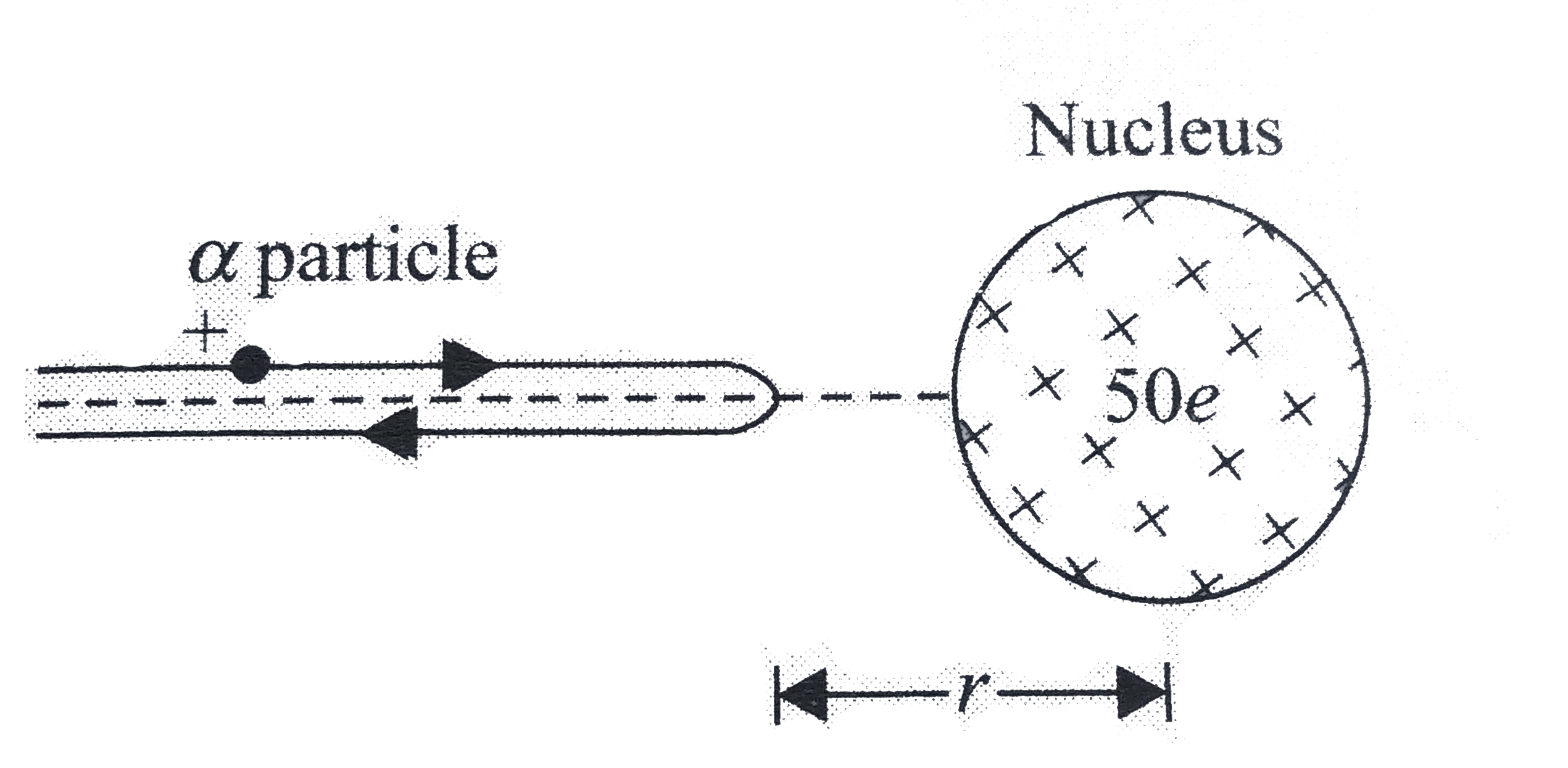A 5MeVα particle is projected towards a stationary nucleus of atomic number 40. Calculate distance of closest approach.
To calculate the distance of closest approach of a 5 MeV alpha particle projected towards a stationary nucleus with atomic number 40, we can follow these steps:
Step 1: Understand the Concept
At the distance of closest approach, the kinetic energy of the alpha particle is equal to the electrostatic potential energy between the alpha particle and the nucleus.
Step 2: Write the Formula
The potential energy (U) between two charged particles is given by:
U=14πϵ0⋅Z1Z2e2r
Where:
- Z1 is the atomic number of the alpha particle (which is 2 for helium),
- Z2 is the atomic number of the nucleus (which is 40),
- e is the charge of an electron (1.6×10−19 C),
- r is the distance of closest approach,
- ϵ0 is the permittivity of free space (8.85×10−12C2/N m2).
Step 3: Set Kinetic Energy Equal to Potential Energy
The kinetic energy (K.E) of the alpha particle is given as 5 MeV. We need to convert this into joules:
K.E=5MeV=5×1.6×10−13J=8×10−13J
Step 4: Substitute Values into the Potential Energy Formula
We know that at the closest approach:
K.E=U
Substituting the values into the potential energy formula:
8×10−13=14πϵ0⋅(2)(40)(1.6×10−19)2r
Step 5: Solve for r
Rearranging the equation to solve for r:
r=14πϵ0⋅(2)(40)(1.6×10−19)28×10−13
Step 6: Calculate the Constants
Using ϵ0=8.85×10−12C2/N m2:
14πϵ0≈9×109N m2/C2
Now substituting the values:
r=9×109⋅(2)(40)(1.6×10−19)28×10−13
Step 7: Calculate the Final Value
Calculating the numerator:
(2)(40)(1.6×10−19)2=2⋅40⋅2.56×10−38=204.8×10−38
Now substituting back:
r=9×109⋅204.8×10−388×10−13=1843.2×10−298×10−13=230.4×10−16m
Thus, the distance of closest approach is approximately:
r≈2.304×10−14m=23.04fm
Final Answer
The distance of closest approach is approximately 2.304×10−14m or 23.04fm.
---
At the distance of closest approach, the kinetic energy of the alpha particle is equal to the electrostatic potential energy between the alpha particle and the nucleus.
The potential energy (U) between two charged particles is given by:
U=14πϵ0⋅Z1Z2e2r
Where:
- Z1 is the atomic number of the alpha particle (which is 2 for helium),
- Z2 is the atomic number of the nucleus (which is 40),
- e is the charge of an electron (1.6×10−19 C),
- r is the distance of closest approach,
- ϵ0 is the permittivity of free space (8.85×10−12C2/N m2).
The kinetic energy (K.E) of the alpha particle is given as 5 MeV. We need to convert this into joules:
K.E=5MeV=5×1.6×10−13J=8×10−13J
We know that at the closest approach:
K.E=U
Substituting the values into the potential energy formula:
8×10−13=14πϵ0⋅(2)(40)(1.6×10−19)2r
Rearranging the equation to solve for r:
r=14πϵ0⋅(2)(40)(1.6×10−19)28×10−13
Using ϵ0=8.85×10−12C2/N m2:
14πϵ0≈9×109N m2/C2
Now substituting the values:
r=9×109⋅(2)(40)(1.6×10−19)28×10−13
Calculating the numerator:
(2)(40)(1.6×10−19)2=2⋅40⋅2.56×10−38=204.8×10−38
Now substituting back:
r=9×109⋅204.8×10−388×10−13=1843.2×10−298×10−13=230.4×10−16m
Thus, the distance of closest approach is approximately:
r≈2.304×10−14m=23.04fm
The distance of closest approach is approximately 2.304×10−14m or 23.04fm.
Topper's Solved these Questions
- ELECTROSTATICS AND CURRENT ELECTRICITY Book:CBSE COMPLEMENTARY MATERIALChapter:ELECTROSTATICS AND CURRENT ELECTRICITY Exercise:LONG ANSWER QUESTIONS
Explore 6 Videos
- ELECTRONIC DEVICES Book:CBSE COMPLEMENTARY MATERIALChapter:ELECTRONIC DEVICES Exercise:NUMERICALS
Explore 7 Videos
- SAMPLE QUESTION PAPER 2019Book:CBSE COMPLEMENTARY MATERIALChapter:SAMPLE QUESTION PAPER 2019Exercise:Section C
Explore 19 Videos
Similar Questions
An α-particle with kinetic energy K is heading towards a stationary nucleus of atomic number Z. Find the distance of the closest approach.
View SolutionAn alpha particle with kinetic energy 10MeV is heading toward a stationary tin nuclcus of atomic number 50. Calculate the distance of closest approach (Fig . 3.23).
 .
.
View Solution
Knowledge Check
If an α-particle is incident directly towards a nucleus then it will stop when the distance between them is the distance of closest approach. Which of these is correct?
AIts kinetic energy is converted into released radiationBWhen its kinetic energy becomes zero then it converts into electrostatic potential energyCAt distance of closest approach the potential energy of the α-particle becomes zeroDA β-particle will show the same behaviour as an α-particleThe distance oif closest approach of an alpha-particle fired towards a nucleus with momentum p is r. What will be the distance of closest approach when the momentum of alpha-particle is 2p?
A2rB4rCr/2Dr/4The closed distance of approach of an α− particle travelling with velocity V towards a stationary nucleus is d.For the closest distance to become d3 towards a stationary nucleus of double of the charge,the velocity of projection of the α− particle has to be
A6VB√6VCV56D3V2
An alpha particle having KE equal to 8.7MeV is projected towards the nucleus of copper with Z=29. Calculate its distance of closest approach.
View SolutionAn α-particle of kinetic energy 7.68 MeV is projected towards the nucleus of copper (Z=29). Calculate its distance of nearest approach.
View SolutionThe closed distance of approach of an α− particle travelling with velocity V towards a stationary nucleus is d.For the closest distance to become d3 towards a stationary nucleus of double of the charge,the velocity of projection of the α− particle has to be
View SolutionAn α - particle after passing through a potential difference of V volts collides with a nucleus . If the atomic number of the nucleus is Z then the distance of closest approach of α – particle to the nucleus will be
View SolutionAn α - particle after passing through a potential difference of V volts collides with a nucleus . If the atomic number of the nucleus is Z then the distance of closest approach of α – particle to the nucleus will be
View Solution